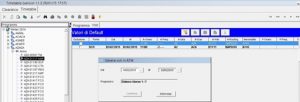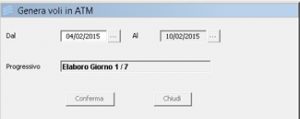OPERATIONS
FLIGHT PROGRAMMING
OVERVIEW
The Time Table is a vital tool for the operational management of an airport as it allows the planning of flights that take place in a season, expressed in terms of rules that describe their occurrence. Multiple Time Tables can be prepared, each of which is associated with a specific seasonal “Program”. A “Program” is a range in which the precise rules established at the airport are valid for all flights made during that period. Within a “Program” the user can also establish a “Period”, ie a shorter interval in which to define, for one or more flights managed by the airport, rules different from what established in the “Program” . Once established a period it is necessary to define the frequency with which the flight is carried out. Defining the frequency means determining whether the flight is monthly or weekly, and in the latter case establishing precise days of arrival or departure. The TimeTable incorporates information from multiple sources, is multifonte “, and is capable of handling conflicts between rules inserted, modified or deleted by different types of data source (eg:” operator “,” SCR “,” ASM “, etc ..) thanks also to the possibility of associating a precise level of priority to each source.
Priority levels are assessed upon activation (instantiation of operating flights) of the flight program. In case of conflict of one or more rules, for one or more attributes, only the rule or the attribute with higher priority is taken into consideration. Priorities must respect the uniqueness constraint. This means that it is not possible to have multiple sources with the same priority or a source with more priorities. Each user must be associated with a “data source” (eg: “operator1”) and therefore, consequently, a priority.
The multi-office management allows an operator to insert in the Time Table the operational schedules of the flight even if different from the official ones received via SCR. For these schedules, the operator has the right to indicate only the attributes that differ from those of lower priority (eg “SCR”) leaving them blank, that is, leaving the fields blank. Assuming to insert an operational schedule of a given flight (eg: with “OPERATOR” source) that only differs for the scheduled time with respect to the official schedule (eg with “SCR” source) it will be necessary to insert a rule for that flight only the fields of “Beginning period”, “End of period”, “Frequency” and the new scheduled time.
Upon the explosion of this rule, the system will report all the attributes present in the official schedule (“SCR”) less than the scheduled time for which the one expressed with the source “OPERATOR” will be instantiated (obviously this result is reached if the latter has a higher priority than the SCR source). The Multifonte Time Table also ensures that all the attributes expressed for a rule always cover the mandatory fields. In fact, it is not possible to insert a rule in a partial way if there is not at least one schedule with a lower priority that complements and completes the mandatory information. Otherwise the system will deny the insertion of this schedule informing the user by means of a warning message.
For the management of flights in code sharing and related flights, the Time Table offers automatic controls that do not allow editing (inserting or modifying) a flight code that has already been scheduled and therefore already present. This offers the enormous advantage of eliminating any possibility of error, guilty or involuntary, by the user.
BENEFITS
The use of this product and of the whole AOSnice framework allows to reach many benefits:
“Cost Saving”
“Passenger Satisfaction”
“Efficiency and Optimization”
“Safety”
“Reliability”
“Maintainability”
“Evolvability and Extensibility”
“Scalability”
“Interoperability”
“Collaboration”
SOLUTION COMPONENTS
FLIGHT ACCOMMODATION
Another function granted by the TimeTable is the instantiation function of the flights in the ATM system, the function is allowed only to enabled users and only for timetables in “activated” status. The instantiation rules of the flights are the same as the automatic instantiation process, with the only difference that the user is offered the possibility to choose a reference time window.
The instantiation function is activated by means of the button on the mask menu bar. Upon activation, the system presents a superimposed mask, like the one presented below,

from which it is possible to insert the desired time interval. The admitted values are all those included starting from the day following the one in progress and until the end of the timetable. The “From” field automatically presents the date following the one in progress, while in the “Al” field the date is increased by seven days compared to the current date.
If you decide to interrupt the instantiation process, click on “Stop”, in this case the system completes only the instantiation of the day indicated in the “Progressive” field. In the next figure, for example, only the instantiation of flights on the first day of the selected interval was completed.

Following the interruption of the process, the “Cancel” key disappears and “Close” appears, allowing you to close the mask. The flights so instantiated will be visible on the ATM “Cycle Log”.
In the Time Table the flights modified following a SCR received in the day will appear on the tree menu with a chromatic highlight in order to be easily identified. The highlight occurs following the request activated by the appropriate button located on the toolbar.
FLIGHT MANAGEMENT TOOLS
Code Sharing flights
Flights in code sharing are presented only against the selection of a primary flight, if there is total correspondence between the rules for the period and frequency of the primary flight and the secondary flight, the share is defined as “correspondent”; vice versa, if the rules do not correspond exactly, the sharing is defined as “partially corresponding”. If, for one of the flights, the corresponding period is absent, the share is defined as “absent”. For each flight in commercial agreement different levels of match expressed by means of text colors are defined, and in particular:
- Black matches the highest match level: corresponding code sharing
- Yellow corresponds to the intermediate match level: partially matching code sharing
Linked Flights
The binding operation between an incoming flight and a departing flight always refers to a period. If there is total correspondence between the period and frequency rules for arrival and departure, the ligation is defined as “strict”; vice versa if the rules do not exactly match the ligature it is called “lasca”. Finally, if for one of the flights the corresponding period is absent the ligation is defined as “absent”. The ligature match level is expressed by means of different text colors, and in particular:
- Black matches the highest match level: tight tie
- Yellow corresponds to the intermediate match level: loose tying
Only if there is a tight tie, and therefore in the case where the incoming flight and the departing flight share the same scheduling frequency for the same period (net of the night stop number), the system presents the entire rotation machine enhancing the data on both the incoming flight and the departing flight.
The Multifonte Time Table allows the insertion, modification and cancellation of scheduling rules for the selected flight only. When selecting a flight with tying rules, and regardless of the nature, the selected flight is automatically identified by the system as a pivot flight (flight currently selected for editing operations). In the case of tight ligation, and despite the simultaneous presentation of the machine rotation, only the rules of the pivot flight can undergo variations. To this end, the module proposes a graphic accelerator to invert the selection of the pivot flight simply by means of a button.
